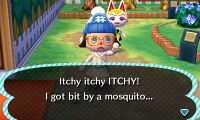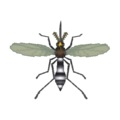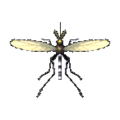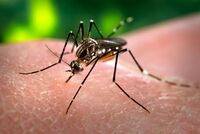Difference between revisions of "Mosquito"
Cephalobot (talk | contribs) m (Text replacement - "\|(.*?)timeday(.*?)=(.*?)\n" to "") |
AlexBot2004 (talk | contribs) m (Text replacement - "PCBugInfo/New" to "PCBugInfo") |
||
| (22 intermediate revisions by 9 users not shown) | |||
| Line 1: | Line 1: | ||
{{Bug Header}} | {{Bug Header}} | ||
| − | |||
{{Infobox Bug | {{Infobox Bug | ||
| − | |name = | + | |name = mosquito |
|ja-name = カ | |ja-name = カ | ||
|ko-name = 모기 | |ko-name = 모기 | ||
| Line 13: | Line 12: | ||
|ru-name = Комар | |ru-name = Комар | ||
|image = Mosquito NH.png | |image = Mosquito NH.png | ||
| + | |icon = Mosquito NH Icon.png | ||
|imagesize = 102px | |imagesize = 102px | ||
|scientific name={{wp|Aedes albopictus}} | |scientific name={{wp|Aedes albopictus}} | ||
|family = {{wp|Culicidae}} | |family = {{wp|Culicidae}} | ||
| − | |||
| − | |||
}} | }} | ||
| − | The ''' | + | The '''mosquito''' (known as the '''island mosquito''' in {{PC|short|nolink}}) is a [[bug]] in the {{SER}} introduced in {{DnM+}}. They fly around on clear [[summer]] nights and will fly toward the player when they are nearby, biting them when they reach them. This causes the player to stop whatever they are doing to acknowledge the bite, although there are no other effects. |
| + | |||
| + | In {{NH}}, it can be caught from [[summer]] to early [[fall]]. | ||
__TOC__ | __TOC__ | ||
| Line 26: | Line 26: | ||
===In {{PG|nolink}}=== | ===In {{PG|nolink}}=== | ||
{{PGBugInfo | {{PGBugInfo | ||
| − | | name = | + | | name = mosquito |
| number = 36 | | number = 36 | ||
| num-plus = 36 | | num-plus = 36 | ||
| Line 58: | Line 58: | ||
===In {{WW|short|nolink}}=== | ===In {{WW|short|nolink}}=== | ||
{{WWBugInfo | {{WWBugInfo | ||
| − | |name = | + | |name = mosquito |
|number = 51 | |number = 51 | ||
|image = Mosquito WW Icon.png | |image = Mosquito WW Icon.png | ||
| Line 66: | Line 66: | ||
|times = 5 PM – 4 AM | |times = 5 PM – 4 AM | ||
|times-peak = 5 PM – 7 PM | |times-peak = 5 PM – 7 PM | ||
| + | |m6=Yes | ||
| + | |m7=Yes | ||
| + | |m8-1=Yes | ||
| + | |m8-2=Yes | ||
| + | |m9-1=Yes | ||
| + | |m9-2=Yes | ||
|location = Flying | |location = Flying | ||
|bug-size= 6 mm | |bug-size= 6 mm | ||
| Line 76: | Line 82: | ||
===In {{CF|short|nolink}}=== | ===In {{CF|short|nolink}}=== | ||
{{CFBugInfo | {{CFBugInfo | ||
| + | | name = mosquito | ||
| number= 59 | | number= 59 | ||
| image= Mosquito CF Icon.png | | image= Mosquito CF Icon.png | ||
| Line 81: | Line 88: | ||
| description= These prefer type-O blood-- its chemical structure is close to flower nectar. | | description= These prefer type-O blood-- its chemical structure is close to flower nectar. | ||
| availability=Jun – Sep | | availability=Jun – Sep | ||
| − | | times=5 PM | + | | times=5 PM – 4 AM |
| m6=Yes | | m6=Yes | ||
| m7=Yes | | m7=Yes | ||
| Line 98: | Line 105: | ||
===In {{NL|short|nolink}}=== | ===In {{NL|short|nolink}}=== | ||
{{NLBugInfo | {{NLBugInfo | ||
| + | | name = mosquito | ||
| number = 66 | | number = 66 | ||
| image = Mosquito NL Icon.png | | image = Mosquito NL Icon.png | ||
| catchphrase = I caught a mosquito! Why you be hatin', mosquito?! | | catchphrase = I caught a mosquito! Why you be hatin', mosquito?! | ||
| − | | availability = Jun | + | | availability = Jun – Sep |
| − | | times = 5 PM | + | | times = 5 PM – 4 AM |
| − | | times-peak = 7 PM | + | | times-peak = 7 PM – 11 PM |
| − | |m6 = Yes | + | | m6 = Yes |
| − | |m7 = Yes | + | | m7 = Yes |
| − | |m8-1 = Yes | + | | m8-1 = Yes |
| − | |m8-2 = Yes | + | | m8-2 = Yes |
| − | |m9-1 = Yes | + | | m9-1 = Yes |
| − | |m9-2 = Yes | + | | m9-2 = Yes |
| location = Flying | | location = Flying | ||
| size = 4.5 mm | | size = 4.5 mm | ||
| Line 116: | Line 124: | ||
| tank-width = 1.0 | | tank-width = 1.0 | ||
| tank-length = 1.0 | | tank-length = 1.0 | ||
| + | }} | ||
| + | |||
| + | ===In {{PC|short|nolink}}=== | ||
| + | {{PCBugInfo | ||
| + | |name = island mosquito | ||
| + | |image = Island Mosquito PC Icon.png | ||
| + | |location = Sunburst Island | ||
| + | |size = 3.7 mm – 5.3 mm | ||
| + | |rarity = ★ | ||
| + | |sell = 10 | ||
| + | |tier = 1 | ||
| + | |catalog-category = Island Excursion Invite | ||
| + | |version-added = 3.1.2 | ||
| + | |availability-latest-start = 2020-03-18 | ||
| + | |availability-latest-end = 2020-03-23 | ||
| + | |availability-latest-event = Island Excursion Bug Goals | ||
}} | }} | ||
===In {{NH|short|nolink}}=== | ===In {{NH|short|nolink}}=== | ||
{{NHBugInfo | {{NHBugInfo | ||
| − | | name = | + | | name = mosquito |
| number = 73 | | number = 73 | ||
| image = Mosquito NH Icon.png | | image = Mosquito NH Icon.png | ||
| + | | render = Mosquito NH.png | ||
| catchphrase = I caught a mosquito! It's itching for a fight! | | catchphrase = I caught a mosquito! It's itching for a fight! | ||
| n-availability = Jun – Sep | | n-availability = Jun – Sep | ||
| Line 148: | Line 173: | ||
==Donating to the museum== | ==Donating to the museum== | ||
| − | As with all [[ | + | As with all [[bug]]s and [[fish]] in the {{SER}}, the mosquito can be donated to the [[museum]] by talking to [[Blathers]], the curator. Upon donation, he will tell the player a little about the donation. Below is what he says in each game: |
===In {{PG|nolink}}=== | ===In {{PG|nolink}}=== | ||
| Line 184: | Line 209: | ||
==Gallery== | ==Gallery== | ||
{{Gallery||Sprites and encyclopedia images}} | {{Gallery||Sprites and encyclopedia images}} | ||
| + | |||
| + | ==Real-world information== | ||
| + | [[File:Aedes aegypti CDC-Gathany.jpg|left|200px|thumb|''Aedes aegypti'', the yellow fever mosquito, feeding on a human.]] | ||
| + | ''Culicidae'', mosquitoes, are a family of small flies covering over 3,600 species spread out around the world; mosquitoes are present in every region aside from ones with polar or subpolar climates, and most are active during twilight. In {{NH}}, mosquitoes are specifically designed after ''Aedes aegypti'', the yellow fever mosquito, which is commonly found in tropical and temperate biomes, such as Africa, the Middle East, and the Americas (including the southern and eastern United States). While mosquitoes typically feed on plant fluids (e.g. nectar) and honeydew, females of most species additionally feed on the blood of other animals, using hemoproteins to produce eggs, which they lay in stagnant water. While all hemovore females are capable of feeding on all animals, different species prefer different hosts, including both warm-blooded animals like mammals & birds and cold-blooded animals like amphibians, non-avian reptiles, and even the larvae of other insects. To facilitate feeding, mosquitoes inject saliva that prevents blood from coagulating; this saliva results in mosquito bites producing itchy, inflamed lumps on the host. | ||
| + | |||
| + | Because they feed on blood, mosquitoes are widely considered pests and biohazards. Large swarms can kill livestock and humans through excessive feeding, and many species are known to be vectors of diseases such as yellow fever, malaria, and zika. In addition to its namesake, the yellow fever mosquito in particular is implicated in transmitting 53 other viral diseases and two species of microbial parasite. These issues result in a number of measures being taken to avoid the risk of bites, including repellents, protective netting draped over beds, the introduction of natural predators to an environment, and traps. Some ecologists have additionally proposed eradicating various mosquito species, generating controversy over the environmental impacts of doing so. | ||
==Names in other languages== | ==Names in other languages== | ||
| Line 211: | Line 242: | ||
}} | }} | ||
| − | {{Bugs}} | + | ==Notes== |
| − | [[Category:Harmful | + | {{Note list}} |
| + | |||
| + | {{Navbox Bugs}} | ||
| + | [[Category:Harmful bugs]] | ||
| + | [[Category:Doubutsu no Mori+ bugs]] | ||
[[Category:Animal Crossing bugs]] | [[Category:Animal Crossing bugs]] | ||
[[Category:Doubutsu no Mori e+ bugs]] | [[Category:Doubutsu no Mori e+ bugs]] | ||
| Line 218: | Line 253: | ||
[[Category:City Folk bugs]] | [[Category:City Folk bugs]] | ||
[[Category:New Leaf bugs]] | [[Category:New Leaf bugs]] | ||
| + | [[Category:Happy Home Designer bugs]] | ||
| + | [[Category:Pocket Camp bugs]] | ||
[[Category:New Horizons bugs]] | [[Category:New Horizons bugs]] | ||
| + | |||
| + | [[es:Mosquito]] | ||
Latest revision as of 21:13, May 6, 2024
| ||||||||
 | ||||||||
| Real-world info | ||||||||
|---|---|---|---|---|---|---|---|---|
| Name: Aedes albopictus Family: Culicidae | ||||||||
| Main appearances | ||||||||
|
| ||||||||
| Other appearances | ||||||||
Names in other languages
カ
모기 Zanzara Mücke
蚊子
Moustique Mosquito Mug
蚊子 Moustique Mosquito Комар | ||||||||
The mosquito (known as the island mosquito in Pocket Camp) is a bug in the Animal Crossing series introduced in Doubutsu no Mori+. They fly around on clear summer nights and will fly toward the player when they are nearby, biting them when they reach them. This causes the player to stop whatever they are doing to acknowledge the bite, although there are no other effects.
In Animal Crossing: New Horizons, it can be caught from summer to early fall.
Catch details[edit]
In Animal Crossing[edit]
In Wild World[edit]
| Description | They drink blood because it's like flower nectar. |
|---|---|
| Time of year | Jun – Sep |
| Time of day | 5 PM – 4 AM |
| Peak times | 5 PM – 7 PM |
| Location | Flying |
| Bug size | 6 mm |
| Selling price | |
| Furniture size |
In City Folk[edit]
| Description | These prefer type-O blood-- its chemical structure is close to flower nectar. |
|---|---|
| Time of year | Jun – Sep |
| Time of day | 5 PM – 4 AM |
| Peak times | N/A |
| Location | Flying |
| Bug size | 6 mm |
| Rarity | Common |
| Selling price | |
| Furniture size |
In New Leaf[edit]
| Time of year | Jun – Sep |
|---|---|
| Time of day | 5 PM – 4 AM |
| Peak times | 7 PM – 11 PM |
| Location | Flying |
| Size | 4.5 mm |
| Rarity | Very common |
| Selling price | |
| Furniture size |
In Pocket Camp[edit]
| Availability | Not currently available
|
|---|---|
| Location | |
| Size | 3.7 mm – 5.3 mm |
| Rarity | ★ |
| Selling price | |
| Version added | 3.1.2 |
| Villager gift data | Tier: 1 (Common)
Rewards:
|
In New Horizons[edit]
| Time of year | North: Jun – Sep South: Dec – Mar |
|---|---|
| Time of day | 5 PM – 4 AM |
| Location | Flying |
| Weather | Any except rain |
| Spawn requirement | Appears from the start of the game |
| Selling prices | |
| Furniture size |
Donating to the museum[edit]
As with all bugs and fish in the Animal Crossing series, the mosquito can be donated to the museum by talking to Blathers, the curator. Upon donation, he will tell the player a little about the donation. Below is what he says in each game:
In Animal Crossing[edit]
In Wild World[edit]
Despite his objection with the insect, Blathers will still give the player a little info on it:
In City Folk[edit]
It can be found flying near the lone palm tree in the middle terrace of the insect exhibit. It bites the player when they stand still for too long.
In New Leaf[edit]
Upon donation to the museum, the mosquito can be found buzzing around in the upper-right room of the Insect section. The exhibit has this to say about the mosquito:
While in the exhibit, it is possible to get bitten by a mosquito.
In New Horizons[edit]
After donation, mosquitoes can be found in a tank in the lab of the bug exhibit area. Unlike previous games, they cannot bite the player as a result of their enclosure.
Quotes[edit]
The player will say the following when bitten by a Mosquito:
- "Yow! I got bit by a mosquito! Man! That really itches..." —Animal Crossing
- "I got bit by a mosquito! So...very...ITCHY!" —Wild World
- "Itchy itchy itchy! I got bit by a mosquito..." —City Folk
- "Itchy itchy ITCHY! I got bit by a mosquito..." —New Leaf
- "Aw, that itches! I got bit by a mosquito..." —New Horizons
Gallery[edit]
Real-world information[edit]
Culicidae, mosquitoes, are a family of small flies covering over 3,600 species spread out around the world; mosquitoes are present in every region aside from ones with polar or subpolar climates, and most are active during twilight. In Animal Crossing: New Horizons, mosquitoes are specifically designed after Aedes aegypti, the yellow fever mosquito, which is commonly found in tropical and temperate biomes, such as Africa, the Middle East, and the Americas (including the southern and eastern United States). While mosquitoes typically feed on plant fluids (e.g. nectar) and honeydew, females of most species additionally feed on the blood of other animals, using hemoproteins to produce eggs, which they lay in stagnant water. While all hemovore females are capable of feeding on all animals, different species prefer different hosts, including both warm-blooded animals like mammals & birds and cold-blooded animals like amphibians, non-avian reptiles, and even the larvae of other insects. To facilitate feeding, mosquitoes inject saliva that prevents blood from coagulating; this saliva results in mosquito bites producing itchy, inflamed lumps on the host.
Because they feed on blood, mosquitoes are widely considered pests and biohazards. Large swarms can kill livestock and humans through excessive feeding, and many species are known to be vectors of diseases such as yellow fever, malaria, and zika. In addition to its namesake, the yellow fever mosquito in particular is implicated in transmitting 53 other viral diseases and two species of microbial parasite. These issues result in a number of measures being taken to avoid the risk of bites, including repellents, protective netting draped over beds, the introduction of natural predators to an environment, and traps. Some ecologists have additionally proposed eradicating various mosquito species, generating controversy over the environmental impacts of doing so.
Names in other languages[edit]
| カ ka |
Mosquito | |
| 모기 mogi |
||
| 蚊子 wénzi |
||
| Комар Komar |
||
| Mug | ||
| Mücke | ||
| Mosquito | ||
| Moustique | ||
| Zanzara | ||
Notes[edit]
- ↑ All bugs and fish in the first-generation games can appear at a lower spawn rate up to five days before the start of their first month of availability.
| Bugs | ||||||||||||||||||||||||||
|---|---|---|---|---|---|---|---|---|---|---|---|---|---|---|---|---|---|---|---|---|---|---|---|---|---|---|
| ||||||||||||||||||||||||||








